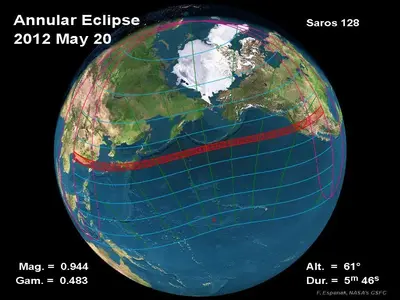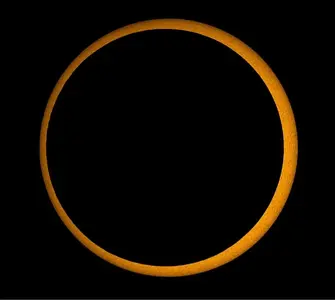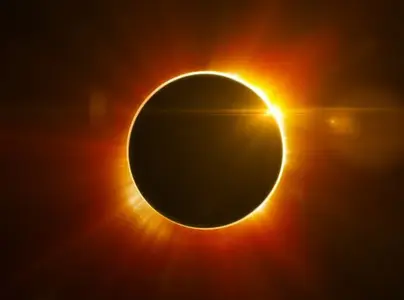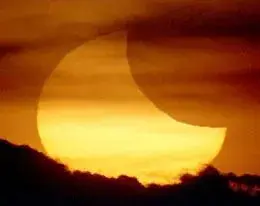Sunday, May 20, 2012 is Annular Solar Eclipse Day.


ANNULAR SOLAR ECLIPSE OF 2012 MAY 20
May 20, 2012, an annular eclipse of the Sun is visible from within a narrow corridor that traverses Earth's northern Hemisphere. The path of the Moon's antumbral shadow begins in eastern Asia and crosses the North Pacific Ocean where it ends in the western United States. The Moon's penumbral shadow produces a partial eclipse visible from a much larger region covering East Asia, North Pacific, North America and Greenland.
This eclipse occurs at the Moon's descending node in central Taurus. An annular eclipse will be visible from a 240 to 300 kilometre-wide track that traverses eastern Asia, the northern Pacific Ocean and the western United States. A partial eclipse is seen within the much broader path of the Moon's penumbral shadow, that includes much of Asia, the Pacific and the western 2/3 of North America
The annular path begins in southern China at 22:06 UT. Because the Moon passed through apogee one day earlier (May 19 at 16:14 UT), its large distance from Earth produces a wide path of annularity. Traveling eastward, the shadow quickly sweeps along the southern coast of Japan as the central line duration of annularity grows from 4.4 to 5.0 minutes.
Tokyo lies 10 kilometres north of the central line. For the over 10 million residents within the metropolitan area, the annular phase will last 5 minutes beginning at 22:32 UT (on May 21 local time). The annular ring is quite thick because the Moon's apparent diameter is only 94% that of the Sun. Traveling with a velocity of 1.1 kilometres/second, the antumbral shadow leaves Japan and heads northeast across the Northern Pacific. The instant of greatest eclipse occurs at 23:52:47 UT when the eclipse magnitude reaches 0.9439. At that instant, the duration of annularity is 5 minutes 46 seconds, the path width is 237 kilometres and the Sun is 61° above the flat horizon formed by the open ocean.
The shadow passes just south of Alaska's Aleutian Islands as the central track slowly curves to the southeast. After a 7000 kilometre-long ocean voyage lasting nearly 2 hours, the antumbra finally reaches land again along the rugged coastlines of southern Oregon and northern California at 01:23 UT (May 20 local time).
Redding, CA lies 30 kilometres south of the central line. Nevertheless, it still experiences an annular phase lasting 4 1/2 minutes beginning at 01:26 UT. It is already late afternoon along this section of the eclipse path. The Sun's altitude is 20° during the annular phase and decreasing as the track heads southeast. Central Nevada, southern Utah, and northern Arizona are all within the annular path.
By the time the antumbra reaches Albuquerque, NM (01:34 UT), the central duration is still 4 1/2 minutes, but the Sun's altitude has dropped to 5°. As its leading edge reaches the Texas Panhandle, the shadow is now an elongated ellipse extending all the way to Nevada. Seconds later, the antumbra begins its rise back into space above western Texas as the track and the annular eclipse end.
During the course of its 3.5-hour trajectory, the antumbra's track is approximately 13,600 kilometres long and covers 0.74% of Earth's surface area.
Partial phases of the eclipse are visible primarily from the USA, Canada, the Pacific and East Asia.
This is the 33rd eclipse of Saros 128. The family began with a series of 24 partial eclipses starting on 0984 Aug 29. The first central eclipse was total and took place on 1417 May 16. After three more totals and four hybrid eclipses, the series changed to annular on 1561 Aug 11. Subsequent members of Saros 128 were all annular eclipses with increasing durations, the maximum of which was reached on 1832 Feb 01 and lasted 08 minutes 35 seconds. The duration of annularity of each succeeding eclipse is now dropping and will reach 4 minutes with the last annular eclipse of the series on 2120 Jul 25. Saros 128 terminates on 2282 Nov 01 after a string of 9 partial eclipses.
The above information is based on the article published in the RASC Observer's Handbook for 2012.
AA





